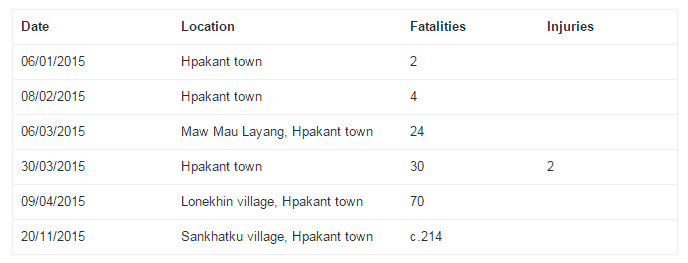The annus horribilis continued at the jade mines in Myanmar, as another major landslide was announced, with at least one fatality and ten people missing.
While local reports seem sketchy and unreliable, it seems that it’s yet another case of a collapse of a waste pile onto informal miners who scavenge the dumps. The local Irrawaddy news service cited a police officer Tuesday:
“The landslide moved slowly, so most of the people working on the waste pile had time to run for their lives,” he said. “According to witnesses, he fell down from a cliff and was buried deeply,” he added, warning of the threat of more landslides in the area. Khin Maung, a miner who witnessed the collapse, told The Irrawaddy that around 20 people had been mining for jade residue at the time of the incident. “The waste pile slowly slid down, with people shouting and running away. Some escaped, but some did not,” Khin Maung added.
The Hpakant area of Burma has suffered a string of disastrous landslides this year, with a disturbingly high number of fatalities.
Over 300 lives lost in a single year, from landslides that could have likely been avoided, or at the very least been mitigated, is an unacceptable number. But why is this happening now, has something changed recently? According to a fascinating article on the Human Rights Watch website, the main culprit is a blatant disregard for the workers’ health, despite skyrocketing profits:
The miners were working at a site used by dozens of Burmese and Chinese companies that have dramatically increased mining in the past year, driving many small-scale miners to scavenge for small jade deposits the machinery misses, in dangerous dump sites where landslides are common. Since large-scale mining resumed in 2014, profits have skyrocketed, but that has done little to reduce the threats to miners’ safety.
Mining companies should be held responsible for the health and safety of their workers, because until then, the number will probably continue to grow. It’s easy to blame all this on illegal mining scavenger, but the reality is that the companies operating the mines should ensure the safety.
Jade trade in the Burma area of Myanmar is one of the significant sources of income, especially in the poorer areas. The jadeite deposits found in Burma’s northern regions is the highest quality Jadeite in the world, so high that some people can even survive by scavenging the remains around the mines. The mining process itself was not without danger. Much of the jade extraction is done by “boulder mining”, which requires removing the “overburden” layer of alluvial material, exposing the rocks below, and separating the jade containing rocks, while discarding the waste in a river. Irresponsible dumping could very well be responsible for these landslides.










